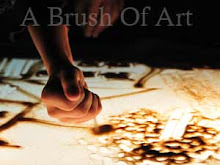To creat images in sand animation, we brush into the sand to create areas of light and shade on a back lighting or bright surface. The marks made stay long enough to be captured frame by frame, which are then changed for the next sequence. Therefore, the illusion of movement is created by slowly modifying the sand frame by frame.
Materials
c) Brushes
d) Coloured sand
e) 4 rectangular wooden block
f) Panel of claer plastic
Set-up
A table or an elevated platform is required to serve as the work area where the sand is controlled and animated on the plastic frame by frame against a light box. A digital video comera is mounted on a tripod and connected to a computer loaded with Adobe Premiere software for stop-motion capture on the table. An ordinary photographic tripod is usually used and the DVC is positioned such that it points downwards st the light box and would shoot the sand from above.
Steps to Sand Animation
1. Construct the basic set up accordingly as shown in the set-up section. Switch on the computer and start the programme Adobe Premiere. Select the function File> Capture> Stop motion.
2. Position the 4 wooden supports for the oanel of glass or plastic such that they support the panel over the light box steadily.
Method 1
i. Pour the coloured sand on the glass and used a brush to shift them in place. Put a tray of a different coloured sand beneath.
ii. Use a pencil to make a mark on the sand. 12 frames of this action are taken.
iii. Use the pencil to draw the desired picture on the sand little by little. 5 frames are taken with every slight change.
iv. When the sequence is completed and replayed, the action sequence will show a smiling face of the colour of the sand beneath.
i. Draw the line drawings of the action sequence that you want to animate to serve as guides to control the sand.It will be the same method as what we have taught in Classical animation., bearing in mind the importance of key frames and in-betwwen frames.
ii. Position the 4 plastic supports for the panel of glass or plastic such that they support the panel over the light box steadily. The first drawing in the action sequence is then slotted underneath the plastic, so that it is illuminated against the light box.
iii. Pour the coloured sand on the plastic and shaped it according to the drawing underneath the transparent panel.
iv. Use a brush to shift the sand into place to create details in the drawing. With the completion of this first sand drawing, 12 frames of this action are taken to mark.
v. The sand is collected and removed after the first frame of the action sequence is taken. The plastic is then ready for the next frame.
vi. The drawing of the next frame is slotted underneath the plastic panel and the sand is poured on it again to create the new image for the second frame of the action sequence. Once completed, 5 frames are taken before the sand is removed and the panel is then ready for the third and subsequent frames of the action sequence.







